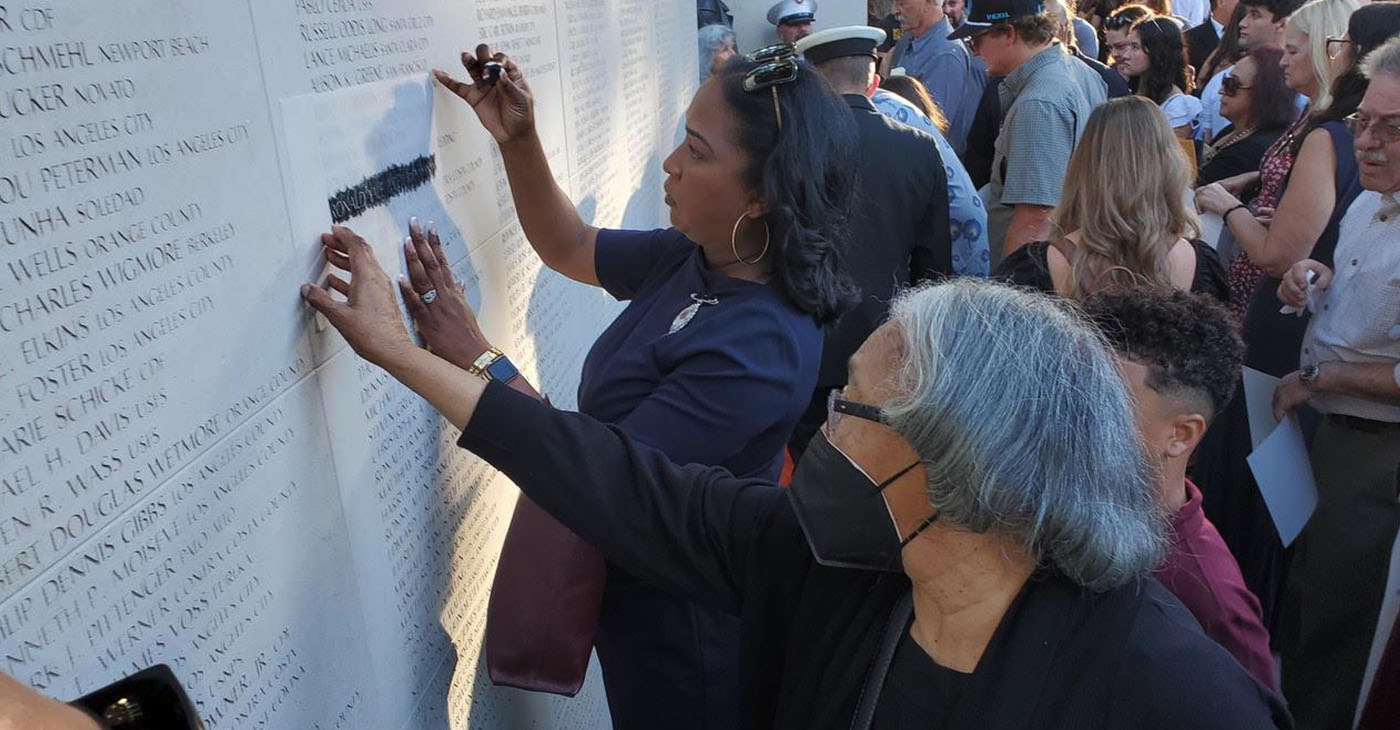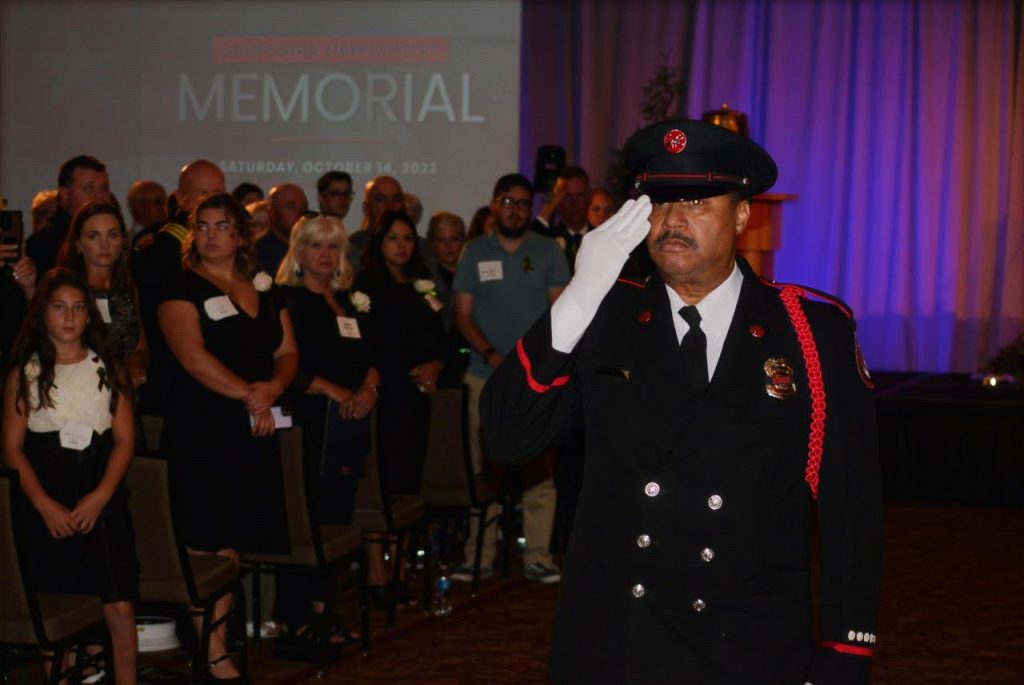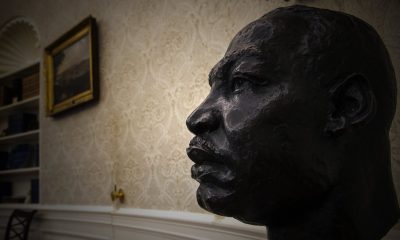Activism
Survivors, Officials Attend State Memorial Honoring 35 Firefighters Who Died on Duty
The state formally presented a United States flag to each of the families of the honorees, whose names are being added to the Fire Fighter’s Memorial Wall in Capitol Park on the east side of the State Capitol.

By Antonio Ray Harvey, California Black Media
The California Fire Foundation hosted its 2023 Annual California Firefighters Memorial and Procession Ceremony on Oct. 14 at the Sheraton Hotel in downtown Sacramento.
Gov. Gavin Newsom, Attorney General Rob Bonta, and Superintendent of Public Instruction Tony Thurmond attended the event, which was organized to honor 35 firefighters who died in the line of duty. Among the honorees was Ronald Yale Wiley, an African American deputy fire marshal from Richmond who died on duty in 2007.
The state formally presented a United States flag to each of the families of the honorees, whose names are being added to the Fire Fighter’s Memorial Wall in Capitol Park on the east side of the State Capitol.
“We’re recognizing and celebrating the life and times of people who tried to make the world a little bit gentler,” Newsom said of the fallen. “They stood tall because they bent down on one knee to help lift other people up. People that came from every conceivable walk of life, political background, and different generations. The 35, we memorialize here today — all with a singular love, and that is a love for public service.”

Thomas Jay, retired Fire Battalion Chief for Riverside, leads the indoor procession at the California Firefighters Memorial Ceremony at the Sheraton Grand Hotel in Sacramento. The event honored 35 firefighters who died in the line of duty. Photo by Antonio Ray Harvey.
Nearly 1,000 people attended the ceremony. The procession showcased firefighting apparatuses and was marked by the presence of hundreds of active-duty firefighters from all over California, forming a “sea of blue.”
Accompanying them were the Pipes and Drums of California Professional Firefighters, honor guards from dozens of fire departments, the families of fallen firefighters from across the state, and various state officials and guests.
The ceremony commenced with a bagpiper playing at the Memorial Wall, a monument built in Sacramento in 2002 to honor the memory, sacrifice and bravery of firefighters who paid the ultimate price while keeping Californians safe.
“When they were called to duty … they came through and they gave as much as anybody is expected to give for their community,” said Brian K. Rice, the president of California Professional Firefighters. “This ceremony is a tribute to that selfless dedication, and more than that, a tribute to the families that stood behind these men.”
In 2007, honoree Wiley was returning to his office from a meeting in Vallejo when the city-owned vehicle he was driving crashed and burned on the Carquinez Bridge on I-80. Wiley, 47, was 16 years into the profession when the incident happened, his son Dante told California Black Media. Dante Wiley attended the ceremony with his wife, children, uncle, and other family members.
“This was a powerful event,” the younger Wiley said of the ceremony. “I brought my three children out here with me so that they can have a better understanding of who my father was.”
Dante Wiley is one of the 20 Black firefighters among Richmond’s 97 firefighters. He said his uncle also spent 30 years as a firefighter in Oakland.
Nationwide, the number of Black professional and volunteer firefighters is relatively low. According to Data USA, there were 324,149 firefighters in the United States in 2021. Of this figure, 4.38% were women and 95.6% were men. Black firefighters represented 7.4% and Hispanics made up 11.2%. White firefighters were 82.2% of the total.
California has around 35,000 firefighters, Rice said at the ceremony. In many jurisdictions, the workforces do not reflect the diversity of the communities they serve. During a 12-year stretch from 1993 to 2005, for example, the San Bernardino City Fire Department (SBCFD) did not hire any Black firefighters.
Now, SBCFD, one of the oldest and largest fire departments in San Bernardino County, has hired a total of 19 Black firefighters, according to Factors Affecting the Hiring of Black Firefighters, a report by James M. Fratus. The late Jimmy Jews became San Bernardino’s first Black firefighter in 1971.
Dante Wiley is actively involved in recruiting efforts.
“I do believe representation matters, and so does education,” Wiley said. “When I mean education, I mean outreach.
“I was fortunate because I saw it every day with my father and, before him, my uncle. A lot of people don’t have that exposure,” Wiley continued. “One of my goals is to get out there and talk to people at high schools, junior colleges, or colleges. Is it for everybody? No. But there are different ways you can go out there and help people. For me, I just want to be of service for my community.”
Activism
Oakland Post: Week of May 21 – 27, 2025
The printed Weekly Edition of the Oakland Post: Week of May 21 – 27, 2025

To enlarge your view of this issue, use the slider, magnifying glass icon or full page icon in the lower right corner of the browser window.
Activism
OPINION: Your Voice and Vote Impact the Quality of Your Health Care
One of the most dangerous developments we’re seeing now? Deep federal cuts are being proposed to Medicaid, the life-saving health insurance program that covers nearly 80 million lower-income individuals nationwide. That is approximately 15 million Californians and about 1 million of the state’s nearly 3 million Black Californians who are at risk of losing their healthcare.

By Rhonda M. Smith, Special to California Black Media Partners
Shortly after last year’s election, I hopped into a Lyft and struck up a conversation with the driver. As we talked, the topic inevitably turned to politics. He confidently told me that he didn’t vote — not because he supported Donald Trump, but because he didn’t like Kamala Harris’ résumé. When I asked what exactly he didn’t like, he couldn’t specifically articulate his dislike or point to anything specific. In his words, he “just didn’t like her résumé.”
That moment really hit hard for me. As a Black woman, I’ve lived through enough election cycles to recognize how often uncertainty, misinformation, or political apathy keep people from voting, especially Black voters whose voices are historically left out of the conversation and whose health, economic security, and opportunities are directly impacted by the individual elected to office, and the legislative branches and political parties that push forth their agenda.
That conversation with the Lyft driver reflects a troubling surge in fear-driven politics across our country. We’ve seen White House executive orders gut federal programs meant to help our most vulnerable populations and policies that systematically exclude or harm Black and underserved communities.
One of the most dangerous developments we’re seeing now? Deep federal cuts are being proposed to Medicaid, the life-saving health insurance program that covers nearly 80 million lower-income individuals nationwide. That is approximately 15 million Californians and about 1 million of the state’s nearly 3 million Black Californians who are at risk of losing their healthcare.
Medicaid, called Medi-Cal in California, doesn’t just cover care. It protects individuals and families from medical debt, keeps rural hospitals open, creates jobs, and helps our communities thrive. Simply put; Medicaid is a lifeline for 1 in 5 Black Americans. For many, it’s the only thing standing between them and a medical emergency they can’t afford, especially with the skyrocketing costs of health care. The proposed cuts mean up to 7.2 million Black Americans could lose their healthcare coverage, making it harder for them to receive timely, life-saving care. Cuts to Medicaid would also result in fewer prenatal visits, delayed cancer screenings, unfilled prescriptions, and closures of community clinics. When healthcare is inaccessible or unaffordable, it doesn’t just harm individuals, it weakens entire communities and widens inequities.
The reality is Black Americans already face disproportionately higher rates of poorer health outcomes. Our life expectancy is nearly five years shorter in comparison to White Americans. Black pregnant people are 3.6 times more likely to die during pregnancy or postpartum than their white counterparts.
These policies don’t happen in a vacuum. They are determined by who holds power and who shows up to vote. Showing up amplifies our voices. Taking action and exercising our right to vote is how we express our power.
I urge you to start today. Call your representatives, on both sides of the aisle, and demand they protect Medicaid (Medi-Cal), the Affordable Care Act (Covered CA), and access to food assistance programs, maternal health resources, mental health services, and protect our basic freedoms and human rights. Stay informed, talk to your neighbors and register to vote.
About the Author
Rhonda M. Smith is the Executive Director of the California Black Health Network, a statewide nonprofit dedicated to advancing health equity for all Black Californians.
Activism
OPINION: Supreme Court Case Highlights Clash Between Parental Rights and Progressive Indoctrination
At the center of this controversy are some parents from Montgomery County in Maryland, who assert a fundamental principle: the right to shield their children from exposure to sexual content that is inappropriate for their age, while also steering their moral and ethical upbringing in alignment with their faith. The local school board decided to introduce a curriculum that includes LGBTQ+ themes — often embracing controversial discussions of human sexuality and gender identity.

By Craig J. DeLuz, Special to California Black Media Partners
In America’s schools, the tension between parental rights and learning curricula has created a contentious battlefield.
In this debate, it is essential to recognize that parents are, first and foremost, their children’s primary educators. When they send their children to school — public or private — they do not surrender their rights or responsibilities. Yet, the education establishment has been increasingly encroaching on this vital paradigm.
A case recently argued before the Supreme Court regarding Maryland parents’ rights to opt out of lessons that infringe upon their religious beliefs epitomizes this growing conflict. This case, Mahmoud v. Taylor, is not simply about retreating from progressive educational mandates. It is fundamentally a defense of First Amendment rights, a defense of parents’ rights to be parents.
At the center of this controversy are some parents from Montgomery County in Maryland, who assert a fundamental principle: the right to shield their children from exposure to sexual content that is inappropriate for their age, while also steering their moral and ethical upbringing in alignment with their faith. The local school board decided to introduce a curriculum that includes LGBTQ+ themes, often embracing controversial discussions of human sexuality and gender identity. The parents argue that the subject matter is age-inappropriate, and the school board does not give parents the option to withdraw their children when those lessons are taught.
This case raises profound questions about the role of public education in a democratic society. In their fervent quest for inclusivity, some educators seem to have overlooked an essential truth: that the promotion of inclusivity should never infringe upon parental rights and the deeply held convictions that guide families of different faith backgrounds.
This matter goes well beyond mere exposure. It veers into indoctrination when children are repeatedly confronted with concepts that clash with their family values.
“I don’t think anybody can read that and say: well, this is just telling children that there are occasions when men marry other men,” noted Justice Samuel Alito. “It has a clear moral message, and it may be a good message. It’s just a message that a lot of religious people disagree with.”
Justice Amy Coney Barrett raised a crucial point, noting that it is one thing to merely expose students to diverse ideas; it is quite another to present certain viewpoints as indisputable truths. By framing an ideology with the certainty of “this is the right view of the world,” educators risk indoctrination rather than enlightenment. This distinction is not merely academic; it speaks to the very essence of cultivating a truly informed citizenry.
Even Justice Elena Kagan expressed concern regarding the exposure of young children to certain materials in Montgomery County.
“I, too, was struck by these young kids’ picture books and, on matters concerning sexuality, I suspect there are a lot of non-religious parents who weren’t all that thrilled about this,” she said.
Justice John Roberts aptly questioned the practicality of expecting young children to compartmentalize their beliefs in the classroom.
“It is unreasonable to expect five-year-olds, still forming their worldviews, to reconcile lessons that conflict fundamentally with the teachings they receive at home,” he said.
As was noted in my previous commentary, “The Hidden Truth In The Battle Over Books In American Schools”, what lies at the heart of these debates is a moral disconnect between the values held by the majority of Americans and those promoted by the educational establishment. While the majority rightly argue that material containing controversial content of a sexual nature should have no place in our children’s classrooms, the education establishment continues to tout the necessity of exposing children to such content under the guise of inclusivity. This disregards the legitimate values held by the wider community.
Highlighted in this case that is before the Supreme Court is a crucial truth: parents must resolutely maintain their right to direct their children’s education, according to their values. This struggle is not simply a skirmish; it reflects a broader movement aimed at reshaping education by privileging a state-sanctioned narrative while marginalizing dissenting voices.
It is imperative that we assert, without hesitation, that parents are — and must remain — the primary educators of their children.
When parents enroll a child in a school, it should in no way be interpreted as a relinquishment of parental authority or the moral guidance essential to their upbringing. We must stand firm in defending parental rights against the encroaching ideologies of the education establishment.
About the Author
Craig J. DeLuz has almost 30 years of experience in public policy and advocacy. He has served as a member of The Robla School District Board of Trustees for over 20 years. He also currently hosts a daily news and commentary show called “The RUNDOWN.” You can follow him on X at @CraigDeLuz.
-

 #NNPA BlackPress3 weeks ago
#NNPA BlackPress3 weeks agoMLK Bust Quietly Removed from Oval Office Under Trump
-

 Activism3 weeks ago
Activism3 weeks agoOakland Post: Week of May 7 – 13, 2025
-

 Activism4 weeks ago
Activism4 weeks agoOakland Post: Week of April 30 – May 6, 2025
-

 #NNPA BlackPress3 weeks ago
#NNPA BlackPress3 weeks agoTrump Abruptly Fires First Carla Hayden: The First Black Woman to Serve as Librarian of Congress
-

 Activism2 weeks ago
Activism2 weeks agoNew Oakland Moving Forward
-

 Activism2 weeks ago
Activism2 weeks agoAfter Two Decades, Oakland Unified Will Finally Regain Local Control
-

 Activism2 weeks ago
Activism2 weeks agoOakland Post: Week of May 14 – 20, 2025
-

 #NNPA BlackPress3 weeks ago
#NNPA BlackPress3 weeks agoBlack America Celebrates African Descent Heritage of Pope Leo XIV























































